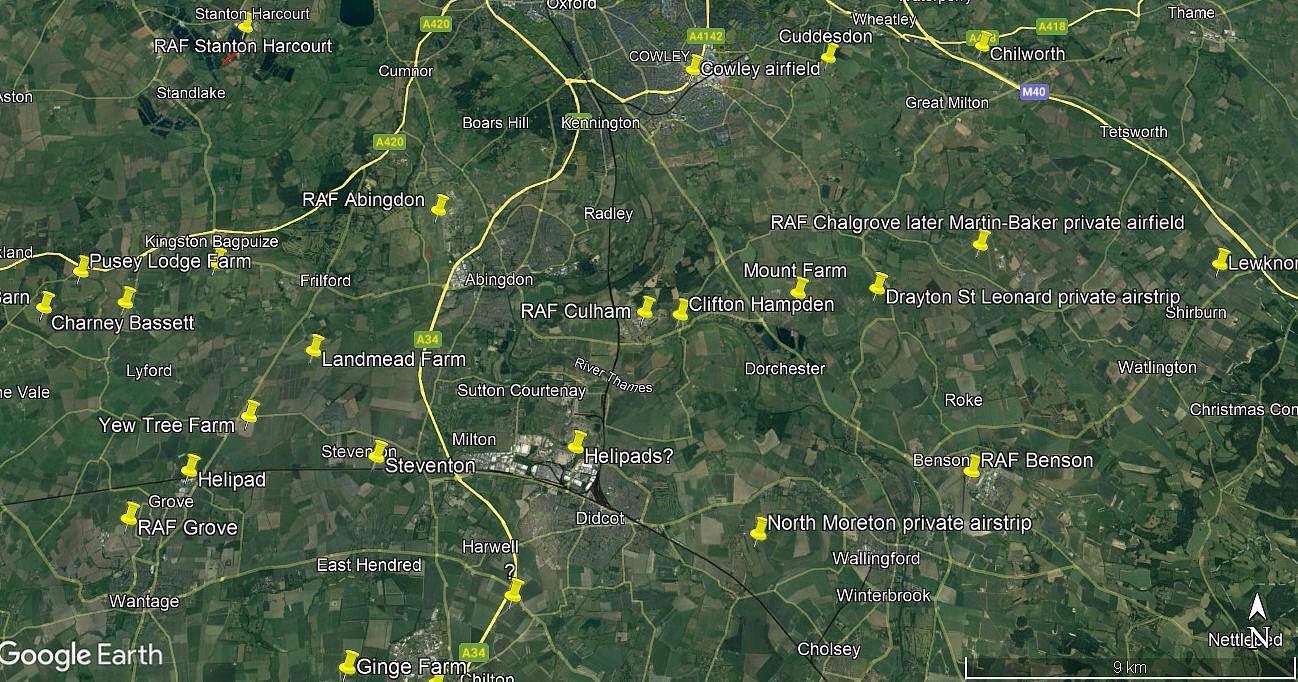Culham flying sites
Note: This map shows the location of the WW2 airfield.
CULHAM: Civil Landing Ground (Aka CLIFTON HAMPDEN)
Note: Both of these pictures are from my Google Earth © derived database. The local view only shows a very rough idea of where the aerodrome was situated. I found it hard to reconcile maps from 1930 with the situation here today.
Operated by: Major G W G Allen, The Elms, Iffley
Location: just E of the village of Culham?
Period of operation: 1929 to 1939
Runways: 1933: Landing runs: N/S 450 grass NW/SE 300 grass SW/NE 250 grass
NOTES: We have Mr Lance Charnes to thank for providing much of this information in April 2023. Including Major Allen having two aircraft based here, G-AAJJ and G-ABKD. Presumably there were couple of other aircraft based here too?
This picture is available to view in the Ashmolean Museum, University of Oxford, and shows Major George Allen standing in front of his Puss Moth.
Major Allen's first aircraft, purchased new from de Havilland for £650 ex works, was the DH60G Gipsy Moth G-AAJJ, which he operated here from around July 1929 until March 1931. After which it appears that the 'joys' of open cockpit flying had faded somewhat.
He then replaced the Gipsy Moth with the de Havilland DH80A Puss Moth G-ABKD, which he had modified for taking aerial photographs, with a vertical and an oblique camera. He had developed a keen interest in exploring and photographing ancient archeological remains. This aircraft was registered to him from 28.03.31 until 27.10.39. Great Britain had declared war on Germany on the 3rd September 1939 and all private flying, and indeed most commercial flying was banned, and the majority of aircraft were impressed into military service. G-ABKD becoming X9403 on the 4th April 1940.
ORIGINAL NOTES:
Hopefully this will be of some interest? In putting this 'Guide' together over the last twenty plus years, (in 2023), it has often been the case that extra information comes to light long after my first listing.
"An AA (Automobile Association) approved Landing Ground, apparently listed as CLIFTON HAMPDEN which doesn’t make too much sense? Quite often I have looked for clues for so many sites to try and determine roughly where they were and this one is a corker which needed a bit of thinking about. For example, when I started this research I’d have thought it obvious it was the predecessor to the military aerodrome listed below, which was adjacent to, and NW of the village of Clifton Hampden".
"But apparently not the case at all, in fact quite the opposite. It needs to be remembered that RAF aerodromes in those days, and indeed during WW2, were invariably named after the nearest Post Office with a telegraph facility and it this case this appears to have been in Culham village".
"To help explain look at a modern road map and you will see that Clifton Hampden is on the A415 at the junction of the B4015 and nothing has changed since WW2. Culham village is roughly 2.5miles further west along the A.415 and another clue given in the AA Guide was that fuel and transport (i.e. a taxi service) was available from “The Railway Hotel Garage, Culham Station (500 yards)”. Therefore on another site roughly 1.5 miles further west than the WW2 aerodrome".
"To help pinpoint the location it was stated that the nearest telephone was available c/o Mr Tremlett at Fullamore Farm 50 yards away. Another unusual feature is that generally the Landing Ground operator can easily be identified as living nearby (if not on site) to the Landing Ground in those days, but not this case in this instance. The Elms in Iffley was situated on the outskirts of Oxford some 5 miles away to the NNE".
CULHAM: Military aerodrome, Royal Naval Air Station (HMS HORNBILL)
Note: This picture was obtained from Google Earth.
Military users: RN Receipt & Despatch Unit
Note: Also it appears, in the years shortly after WW2 ended, a training unit for RNAS reservists in the Thames Valley area was based here flying North American T-6 Harvards, Vickers-Supermarine Seafires and Hawker Sea Furies.
In 1947 it appears the Photographic Trials & Development Unit were based here for a while.
Location: Just NW of Clifton Hampden village, 2.5nm SE of Abingdon town centre and roughly 6nm SSE of Oxford city centre
Period of operation: 1944 to 1953
Runways: 1944: 06/24 1097x27 hard 10/28 1280x27 hard
16/34 1097x27 hard
NOTES:
There is a mention that 1840 Naval Air Squadron spent a short time here in 1951. If correct, according to the information I can find, this seems of interest. It appears that 80% of the pilots in this squadron were from the Royal Netherlands Naval Aviation Service, but, were they still flying Grumman Hellcats in those days?
This site was, it appears, later used from 1960 by the Atomic Energy Commission and is not to be confused with nearby HARWELL aerodrome which was also adopted by the Atomic Energy Commission just a couple of miles or so further south, with I would say, a far bigger establishment.
It appears that in recent years this site is dedicated to the Joint European Torus (JET) nuclear fusion project. Gawd help us if they that get that wrong in tests.
Terry Rodell
This comment was written on: 2021-04-05 19:02:30In the very late 60's /very early 70's the airfield was used as a rally special stage venue. I competed there twice after the first time the RAC banned single stage venues. The 2nd time a stage at Didcot power station was added.
We'd love to hear from you, so please scroll down to leave a comment!
Leave a comment ...
Copyright (c) UK Airfield Guide



















